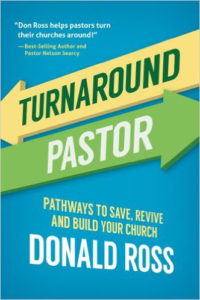Successful Turnaround efforts in a local church will add new people to the fellowship. Some will be transfers from other churches. Many times those already committed to Christ and His church move to new communities while others may leave a church environment they view as uncomfortable or even toxic. Growth by transfer is important to conserve the overall impact of The Church. Nevertheless, when the church receives transfer members the local church grows but The Church does not.
Real Turnaround then must focus on conversion growth rather than transfer growth. Conversion growth means that those who come to personal faith in Christ will also come into the fellowship of the church that won them.
In the not too distant past, churches relied on the visibility of their buildings or on a simple advertising campaign to attract new participants. Bill Easum describes an early effort to attract people to church by borrowing a piece of earth moving equipment and pushing piles of dirt across the church lawn. The visibility of apparent construction activity helped gain a crowd. (See Go Big!). This was in a day, however, when people routinely went to church so the main goal was to gain recognition of location. An early mentor of mine pointed out three criteria for church growth: location, location, location! Many suburban housing developments in the 60s and 70s routinely allowed for a few lots to be sold to churches. The church growth strategy in those days was that people from the immediate locale of the building would simply show up because everybody went to church.
In the 21st century buildings do not win people, nor do programs guarantee church growth. For example, in recent generations young families would be attracted to church about the time the children entered public school. In those days an effective children’s program guaranteed the growth of a church since religious education was the driving motive in a family’s return to church.
In the 21st century neither programs nor buildings guarantee church growth.
How then does a church experience turnaround? Only when church leaders understand that people win people will a church be ready to take the first steps in turnaround. When it comes right down to it only four processes grow a church and anything else has little to no impact. These four core processes are:
- Inviting people to Christ and the Church,
- Connecting with those who show up so they return,
- Discipling those who stay, and
- Sending them back out into the world to be neighborhood missionaries.
This basic premise of the Turnaround 2020 initiative is that people win people. Thus, we must teach, train and motivate people in our congregations to share their faith with people in their spheres of influence so that folks may be won to Christ and to the local church.
The starting point for this faith sharing process should never be an attempt to guilt or shame folks into sharing their faith. Rather, the starting point is simply the beginning point of a pastor leading by example. Pastors who are soul-winners will lead churches that are soul-winning churches. Pastors would do well to ask some significant questions:
Pastors must also focus on a disciple making process for new believers. When people new to the faith are encouraged to share their faith, accelerated conversion growth can be realized. This means that the most important person to reach is the next one. Winning the next person to faith in Christ sets the stage to connect with a whole range of friends, relatives, and neighbors of the newly converted, properly discipled believer.
A discouraged pastor recently reported, “We’ve surveyed all the homes around the church. We’ve knocked on all the doors but they still won’t come.” Door-to-door work produces fewer results these days. The key to winning people is not cold-calling but the development of a warm, friendly relationship.
JUMPSTART YOUR MINISTRY: START WITH THE BASICS
 So where does a pastor who wants to reach people start the process?
So where does a pastor who wants to reach people start the process?
- Connect with guests who have attended your church recently. Use the information gained from their connection cards to establish personal relationships that extend over several weeks/months. For some specific strategies see Fusion by Nelson Searcy go to www.textinchurch.com for suggestions.
- Cultivate people/families for whom you have provided needed pastoral services such as funerals and weddings. Find a way to support connections with them for at least 3-6 months as you get acquainted and as you invite them to share your faith in a natural setting.
- Track your movements throughout the week. Who is it that regularly comes into your sphere of influence? Bi-vocational pastors have the edge here since they are vocationally connected to people in their business or professional capacities. Some studies I have read suggest that bi-vocational pastors, overall, perform better at winning people than do vocational pastors.
- Commit yourself to a minimum number of witnessing efforts every week. Keep a written record and hold yourself accountable.
The goal is rather simple. You are to move people from the prospect list to the guest list to the membership list. You cannot teach others until you have mastered the process yourself. You can’t wait for others to get started first. This urgent task needs your immediate attention so Turnaround may begin!


